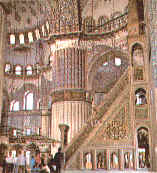|
|
"There, God, man, nature and art have together created and placed the most marvelous point of view that the human eye can contemplate on earth."
Lamartine's words are fitting tribute to this unique city, rising from the sparkling waters of Bosphorus into striking skyline of domes and minarets, bridging the continents of Europe and Asia and linking Black Sea to Sea of Marmara.
This strategic setting has dictated the city's destiny as an imperial capital for 1600 years. Istanbul is founded 2600 years ago and was made Roman capital by Emperor Constantine, and following the division of the empire, it became Byzantine metropolis. In 1453, the city that possessed the mightiest fortifications of Western world fell to Ottoman Turks, led by their tempestuous young sultan, Mehmet II.
In the most cosmopolitan of cities, past and present are synthesized. Byzantine brilliance and Ottoman opulence blend into this bustling port city, with its great liners at anchor and its little fishing boats bobbing on the waves.
Everywhere the city contrasts are apparent, from the sirens of ships to the timeless sound of muezzins calling the faithful to prayer, and from the sunlight flashing off the golden crescents on the domes of mosques to the hypnotic gaze of Byzantine mosaic figures.
So often silhouetted by flaming sunset in the old city, set on triangular promontory between Golden Horn and Bosphorus, and defended on the landward side by the massive Byzantine walls. Here Emperor Justinian built Christendom's greatest church, St. Sophia.
Yet rivaling the basilica in magnificence are Mosque of Sultan Suleiman the Magnificent, built by Turkey's greatest architect Sinan, and Mosque of Sultan Ahmet I, Blue Mosque, with its six minarets and blue Iznik tiles.
Dominating the old city is the mysterious labyrinth of Topkapi Palace, the seat of Ottoman sultans for 300 years. It was here that the power politics of ruling an empire, that stretched from the Gates of Vienna to Persian Gulf, were played out against background of harem intrigue. The jeweled turban crests, silken kaftans and priceless Chinese porcelains of the palace, bear witness to the grandeur of bygone era.
Beside Topkapi Palace is Hippodrome and the heart of another empire. The calm of Hippodrome today contrasts with its violent Byzantine past of reckless chariot races and rebellion that left 30,000 corpses on this spot. Just inside the city walls is the other face of Byzantine world, the formalized splendor of the mosaics of St. Saviour in Chora.
From this kaleidoscope of past civilizations to patchwork of crafts and Istanbul's great Covered Bazaar. Within this maze of shops is an array of all Turkey's crafts; the sparkle of jeweler, the glint of beaten copper and the rainbow colors of oriental carpets.
Indeed, Turkish crafts are but a reflection of this colorful country, and one has only to look at Istanbul's natural setting to appreciate the vividness of these hues, from the deep blue of Bosphorus to the dark green of the cypresses lining its blank.
Here too, on Bosporus, is another collage of bygone grace and jet-age living. As the boat, which leaves Galata Bridge zigzags up Bosphorus, the eye darts from lovely Ottoman wooden villas or "Yali" to the bold forms of modern hotels, from the gaily painted hulls of fishing boats to the sleek lines of racing yachts, and from the humble fishing villages to the dramatic outline of Bosphorus Suspension Bridge, the newest symbol of the link between East and West.
With night the city bursts into brilliance of another kind; glasses clink over plates of sea food and sequins shimmer with the tinkle of tiny cymbals as oriental dancers express the age old seduction of East.

Blue Mosque
|
|

